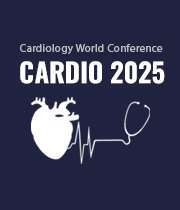Title : Restrictive cardiomyopathy diagnostic approach
Abstract:
A 28-year-old male presented with signs of heart failure. Evaluation revealed idiopathic restrictive cardiomyopathy (IRCM), a rare condition marked by diastolic dysfunction with preserved systolic function. This report highlights the role of clinical features and non-invasive imaging in diagnosing IRCM.
Introduction: Restrictive cardiomyopathy (RCM) is a rare myocardial disorder characterized by impaired diastolic filling and normal systolic function. Ventricular compliance is reduced despite near-normal chamber sizes, often leading to systemic and pulmonary congestion [1]. The incidence is approximately 6 per 100,000, more common in elderly females [2]. A notable subtype, endomyocardial fibrosis (EMF), is reported from Kerala, India [3]. IRCM, however, is uncommon in young males.
Case Presentation: A 28-year-old male reported two years of exertional breathlessness, fatigue, pedal edema, and abdominal discomfort, worsening in the last two months. Examination showed hypotension, irregular pulse, raised JVP with prominent “y” descent, murmurs of mitral and tricuspid regurgitation, ascites, and hepatomegaly. ECG showed atrial fibrillation [Fig-1]; chest X-ray revealed cardiomegaly [Fig-2]. Echocardiography demonstrated biatrial enlargement, preserved biventricular function, AV valve regurgitation, and mild pulmonary arterial hypertension (PAH) [Fig-3]. Cardiac catheterization confirmed severe MR and TR, elevated filling pressures, and a restrictive pattern, with no signs of EMF.
Discussion: This young patient with heart failure symptoms, AF, and biatrial enlargement without ventricular dilation raised suspicion of RCM. Echo findings supported IRCM diagnosis, showing restrictive Doppler flow with normal ventricular size. Absence of apical obliteration or calcification ruled out EMF. Cardiac catheterization findings reinforced the diagnosis [4]. Endomyocardial biopsy was not performed due to limited utility in idiopathic cases. IRCM can present with rhythm disturbances like AF and normal QRS voltages. Doppler typically shows increased E velocity, high E/A ratio (>2), and short deceleration time (<150msec) [5]. Differentials include infiltrative and systemic diseases like amyloidosis, sarcoidosis, and hemochromatosis, which usually have endomyocardial involvement.
Conclusion: IRCM should be suspected in young patients with heart failure symptoms and preserved systolic function. Echocardiography and catheterization are essential for diagnosis. Early detection is crucial due to limited treatment options and poor prognosis.



